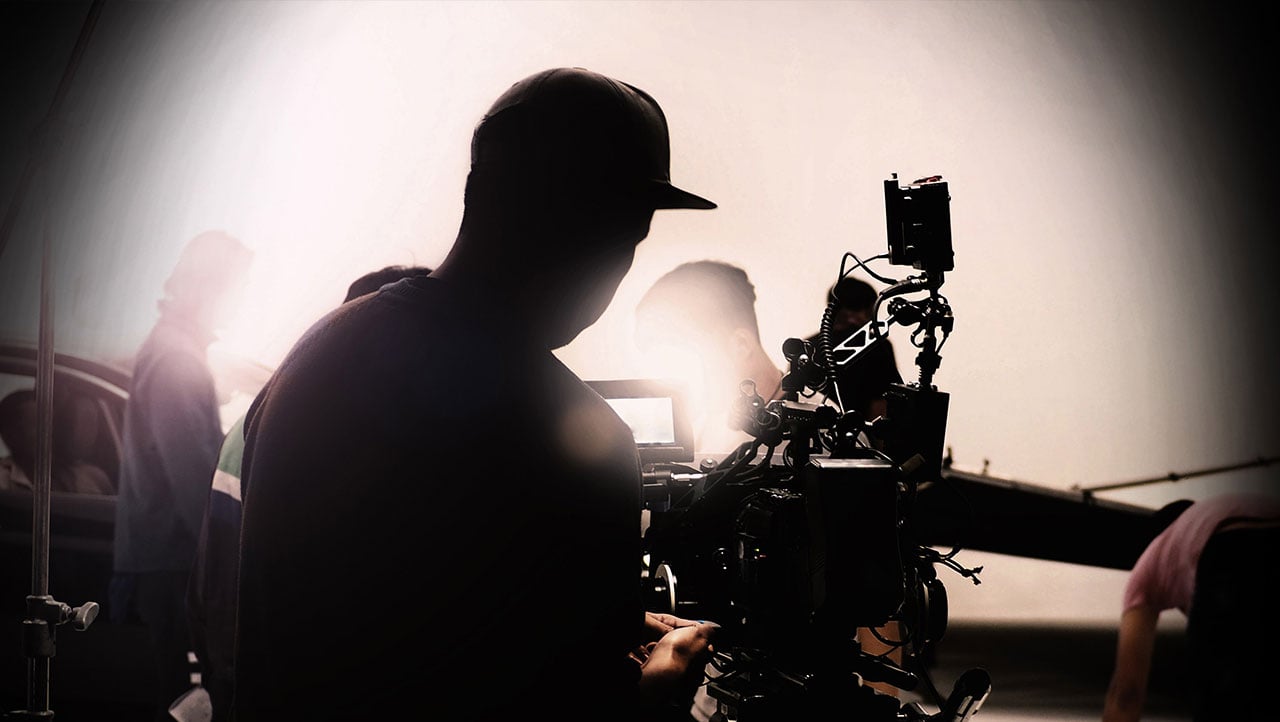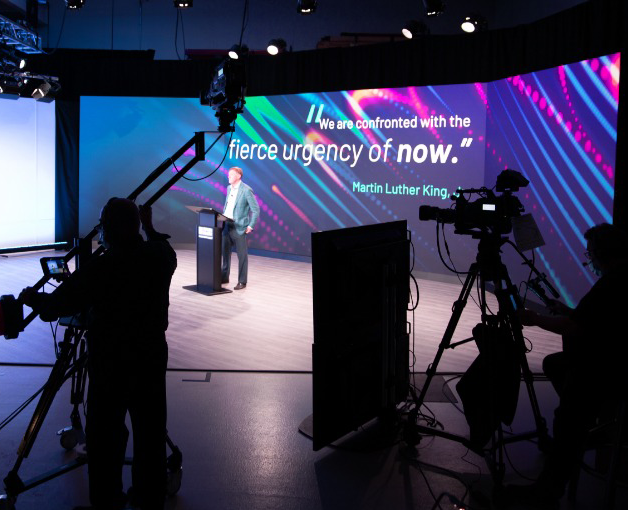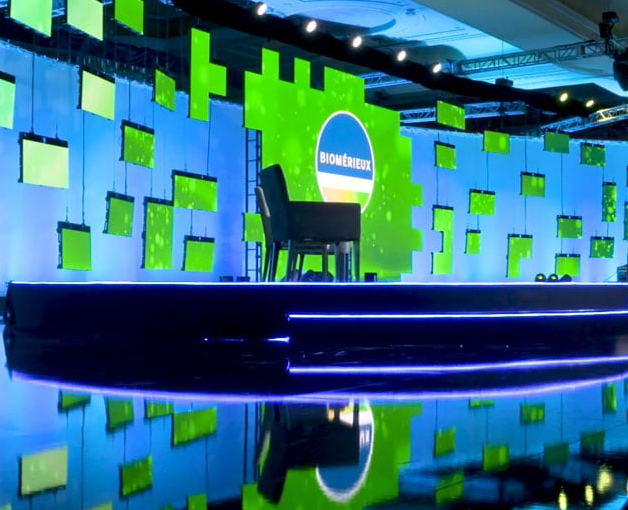How STAGEDGE Took a Global Life Sciences Company’s Virtual Corporate Event to the Next Level
 In late 2023, a global life sciences company approached Stagedge for help hosting a key virtual event for its leadership team, with 475 of those executives based around the world. The event would feature pre-recorded video segments, online breakout sessions, and live hosted by members of the company’s senior leadership team—and the company was looking for ways to take the virtual corporate event to the next level.
In late 2023, a global life sciences company approached Stagedge for help hosting a key virtual event for its leadership team, with 475 of those executives based around the world. The event would feature pre-recorded video segments, online breakout sessions, and live hosted by members of the company’s senior leadership team—and the company was looking for ways to take the virtual corporate event to the next level.
Working at record speed, the Stagedge team focused its efforts on four crucial customizations that wowed attendees, pushing the limits of what a "virtual event" can be.
1. Building a TV Studio, On-Site
The company was looking for ways to deliver an even more impressive and streamlined experience than the previous year's event, which a different corporate event production company had overseen. Stagedge identified a key way to make a difference: building an event studio in their corporate headquarters. This would allow them to control every aspect of the space and give them more options to work with, from audio/visual setup to set design.
"We basically took a large conference facility and transformed it into a studio space, which meant popping out ceiling tiles and finding areas where lights could hang," explains Mark Gionet, Stagedge account executive. "We built a top-notch TV studio in a space that wasn't designed for it."
One Studio, Multiple Uses
While the company’s virtual event studio was built for a single event, the return on investment had an eye on the future. Before the studio was disassembled it was used to further the company’s marketing and communications strategies, including recording segments for other corporate events.
The studio modifications included constructing a stage and adding additional lighting, which required working with the building management team to get extra power delivered to the room. Stagedge also created stage design elements and backdrops that could be moved on and off stage, providing maximum flexibility for the overall production. These design options were needed to get the most value out of the motion camera used in the live-hosting segments, which contributed to the feel of a real studio production.
The company executives were thrilled with the ease of access to a professional-caliber studio and the overall quality of the production environment.
"We had a pretty intricate lighting setup, which allowed for different segments to have different feels," says Jason Kershner, Stagedge director of video production. "We efficiently handled the lighting, making adjustments every time folks moved to a new location." The end result? The company executives were thrilled with the ease of access to a professional-caliber studio and the overall quality of the production environment.
2. A Technology Platform That Allowed For Customization
Next, a versatile technology platform was needed that could handle a virtual event incorporating pre-recorded video, online breakout sections, and live-hosting. All aspects of the production also needed to align with the client's existing technology environment.
"Our team came in—not only from a platform side of things, but also from the streaming side of things—and worked to check all the boxes that were required by the client's security, compliance, and IT teams," says Mike Basteri, senior director of client experience and solutions.
The company required more than a dozen different breakout sessions for their specific areas of business as well as on-demand learning modules that attendees could review throughout the week of the event. Stagedge created a system that allowed users to attend specific sessions within the virtual environment. After registering with their email addresses, attendees gained access to the event platform and their own customized, predetermined event journey, allowing them to view the livestream portions and pre-recorded content, enter breakout sessions, and then return to the livestream. The breakout rooms utilized Microsoft Teams, the company’s chosen collaboration platform, which meant that users were already familiar with the technology. Attendees were also able to participate in a live Q&A session, as well as a post-event survey.
Our team came in—not only from a platform side of things, but also from the streaming side of things—and worked to check all the boxes that were required by the client's security, compliance, and IT teams.
"The post-event survey reflected very positive experiences by attendees," notes Gionet. "In fact, the most positive survey results the company had ever received for this annual event!"
3. Helping Busy Executives Put Their Best Foot Forward
One aspect of virtual corporate events that often goes unappreciated is the amount of time and attention they require from busy executives. Managing production timelines in a way that was mindful of stakeholders' time was very important to the success of this client’s event. And since much of the recording and editing process needed to happen over the holiday season, client time was even more precious.
To make the process as easy as possible for company leadership, the Stagedge team worked hard to ensure a quick turnaround time on content editing and approvals. Videos were pre-edited before being sent to stakeholders for approval, freeing them from wasted time scrolling through raw footage. "They couldn't believe how quickly we were able to turn things around, and they were very happy that executives were able to review things quickly. It helped in terms of building the show quickly," says Kershner. Early outreach by Stagedge to understand and align the event's objectives and content also helped ensure these quick turnarounds.
They couldn't believe how quickly we were able to turn things around, and they were very happy that executives were able to review things rapidly.
Another timesaving effort focused on the client's scripts for the event. Stagedge's executive producer worked closely with the client to review presentation scripts, suggest and work through changes, and eventually align on how to shoot the event so that it had the smooth flow of a TV show. This process also involved working closely with the livestream presenters. "We took a very proactive approach in coaching them on how to work and present in a studio space like that," says Kershner. This close work with the client's executive team led to an expedited production timeline and a more effective final product—and gave the company’s executives the confidence they needed to put their best foot forward.
4. Making Creative Process Adjustments, On-The-Fly
The event highlighted Stagedge's ability to create on-the-fly and adapt as needed. The client had a clear brand identity and wanted the event production to align with it. Starting with the client's concept, Stagedge quickly created graphics and other visual elements to complement the brand, including split-screen graphics, lower thirds, and opening and closing animations. "Everything we did was on-brand in that broadcast—all of their corporate branding, colors, and logos," explains Kreshner. "It felt like a TV show spin on their existing brand."
Some of the company's executives who were experienced with video and event production; said the work that Stagedge delivered stood out among their previous experiences with corporate event management companies. "Based on the client's reactions, we could tell that all of our attention to detail—the efficiency of turnaround, the branding, the way we leveled up to meet the client's vision—it really went a long way with them," says Kershner.
Learn How It's Done, Behind the Scenes
There are many moving parts to pulling off a sophisticated virtual corporate event—but we've got you covered. Need help making your speakers shine? Check out our blog with tips for "Coaching Your Keynote." Wondering how we pull off top-of-line video production? Read How to Up Your Game with Video Production. Still wondering how you'll manage to pull it off? Contact us for a quick call to learn more.
--
Stagedge: Creating Immersive Experiences for nearly 50 years is proud to be one of Boston's premier full-service event production companies dedicated to conceiving, creating, and executing immersive brand experiences through live, virtual & hybrid events, domestically and worldwide.
.



